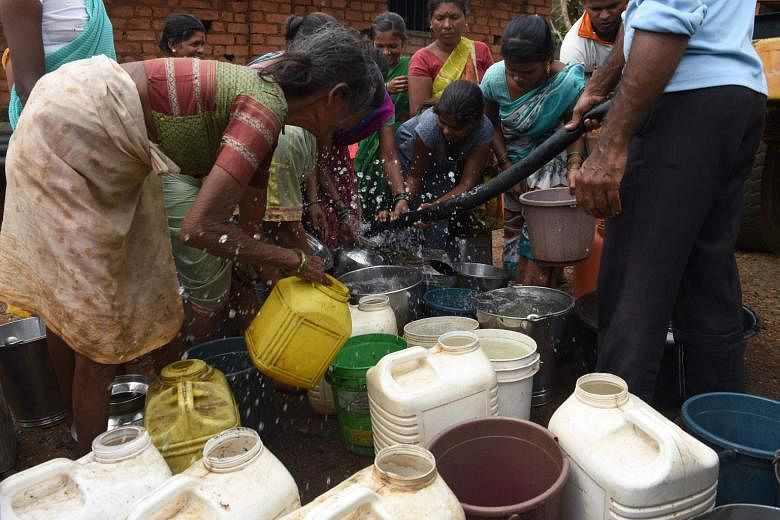SHAHAPUR, INDIA (AFP) - As Gajanand Dukre parks his water tanker in a drought-stricken Indian village, dozens of locals - mostly women in saris - come running with jerrycans, buckets and stainless steel pots.
Over the next two hours, Mr Dukre helps them empty the 12,000-litre tank, providing a lifeline to this small community as India reels from one of its worst droughts in years.
"We are working overtime," says 41-year-old Dukre, who conducts four rounds of deliveries a day to hamlets around Shahapur in the parched western state of Maharashtra.
Mr Dukre is one of 37 drivers operating government-run water tankers in the area, which is situated around 100km from India's financial capital Mumbai.
The tankers run seven days a week between March and June, when water is at its scarcest in India.
The Asian giant's hot season has been particularly harsh this year, with temperatures rising above 50 deg C in Rajasthan state.
Almost half of India - an area home to more than 500 million people - is facing drought-like conditions because of deficient pre-monsoon rainfall, according to the Indian Meteorological Department (IMD).
In Shakar Pada village, water levels in the well are dangerously low, meaning villagers are relieved to see Mr Dukre roll in, attach a hose to the back of the tanker and start to fill up everyone's vessels.
"There has been a scarcity of water for the past month," Ms Pramila Shewale tells AFP as she carries a freshly filled pot of water on her head to her home.
"If it wasn't for the water tankers, we would have to rely on the well, which would be very difficult," the 25-year-old adds.
The village's 98 families survive on agriculture, growing mostly rice and vegetables that they sell at markets in nearby cities. During drought, there is no water for agriculture or livestock.
Falling groundwater levels and poor irrigation techniques mean they are overly reliant on India's June-to-September south-west monsoon, which provides the country with most of its annual rainfall.
Three of the last five monsoons have been deficient, and while the IMD is predicting a normal monsoon this year, it is already a week late, and that worries farmers.
"Every year, the drought gets worse. I pray to God that there is sufficient water (this time)," Mr Naresh Rera, a 32-year-old farmer said.
Mr Dukre will keep delivering water until the monsoon is in full swing in Maharashtra, likely by the end of the month.
Every night, he and his colleagues sleep in their vehicles, with the tankers lined up on wasteland beside a dammed river.
They wake at 3am, fill the tanks with water from the river, pour in chlorine and head to the parched villages.
Then they come back, fill up and head out again. Often, Mr Dukre doesn't finish his rounds until 7.30pm.
"It's hard work but my heart feels good because I am helping people," he says.

